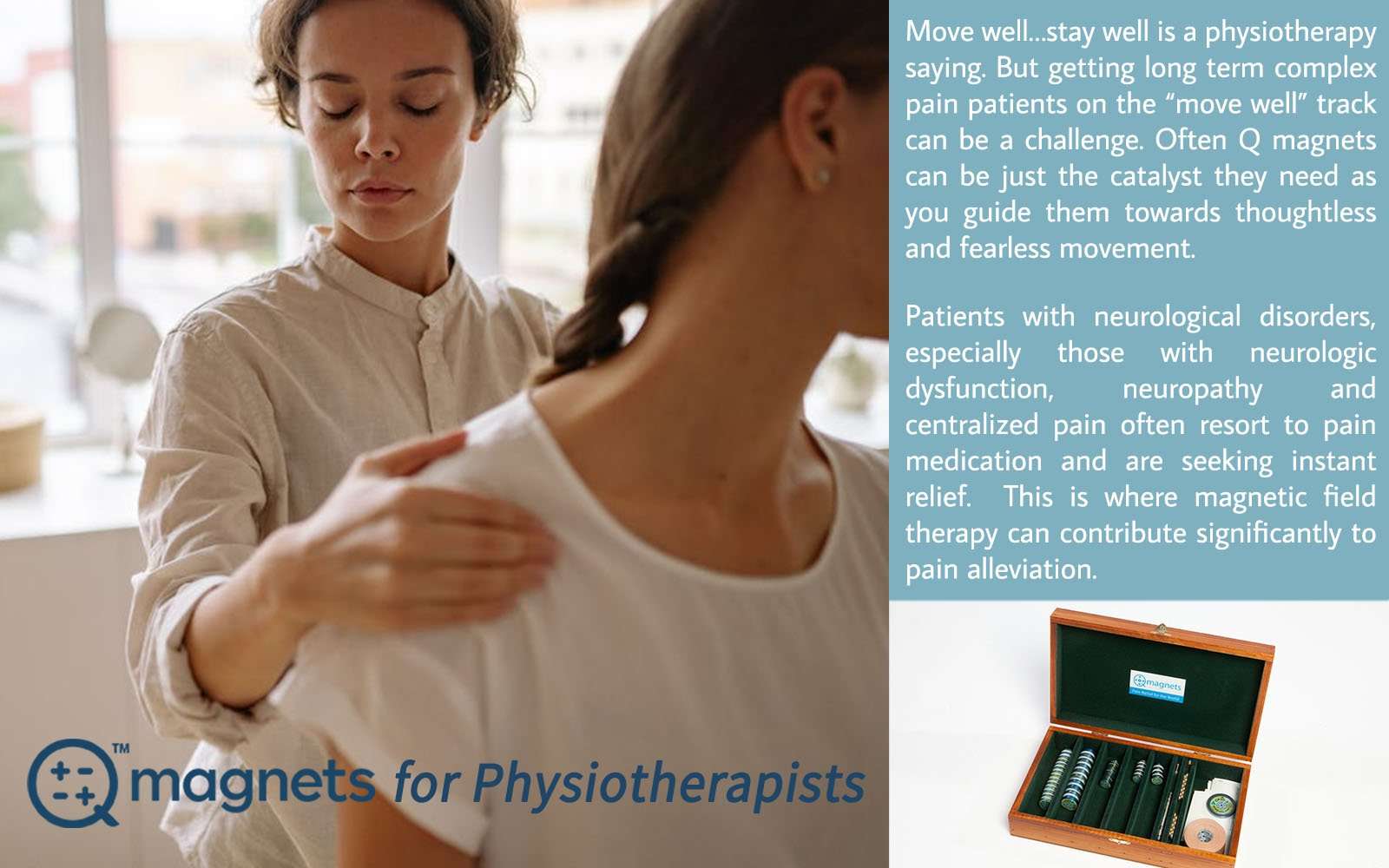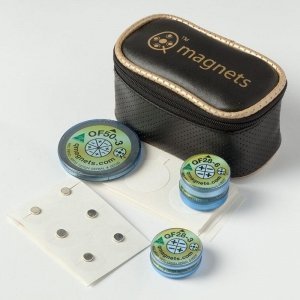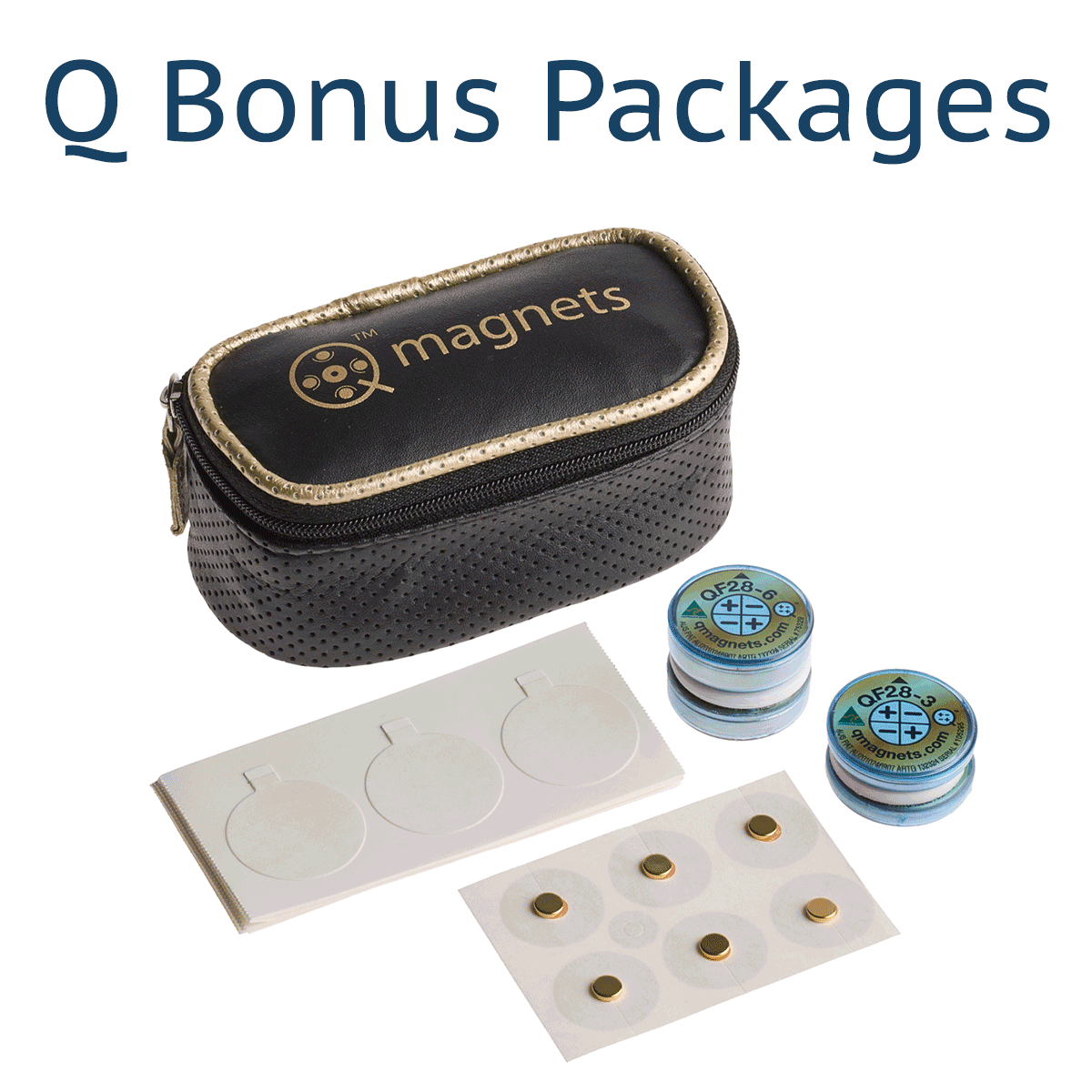Magnetic Therapy for Physiotherapy Practice or Clinic
Move well…stay well is a physiotherapy saying. But helping long term complex pain patients get on the “move well” track, can be a challenge. Giving patients a boost, gives them hope and confidence they are in the right hands. Often Q magnets can be just the catalyst they need as you guide them towards pain free movement. See case study for example… Q magnets fast track treatment progression after 10 year chronic pain history.
MRI is considered the ultimate in medical imaging. TMS or magnetic brain stimulation can benefit medication resistant depressions. They provide evidence that magnetic fields are a new frontier in medicine. Both hard-to-treat depression and hard-to-treat pain can benefit from the therapeutic effects of an optimised magnetic field.
Physiotherapy services such as strength training, therapeutic exercises, and education certainly help heal the musculoskeletal systems. However patients with neurological disorders, especially those with neurologic dysfunction, neuropathy and centralized pain often resort to pain medication and are seeking instant relief. This is where magnetic field therapy can contribute significantly to pain alleviation.

It’s generally accepted, that in around 20% of cases, patients live with complex conditions that simply don’t fit within the box. What happens when one of these patients sees a physiotherapist with no adjunct treatments like magnetic field therapy? They’ll get seen 3 or 4 times and referred on, back to their doctor and then most likely to specialists. Or they can see a skilled physio who has a vast range of skills in their clinical toolbox to choose from and actually help the patient to get better.
Therefore, physiotherapists, massage therapists and kinesiologists should use an integrative health approach to improve the quality of a patient’s life. Leading physiotherapy colleges such as the University of Southern California recommend an inter-disciplinary approach for physiotherapists to benefit the society at large. More health professionals are adopting this technology as it’s quick and simple to apply and you can find no side effects.
Effectiveness of Magnetic therapy for Physiotherapy
In the last 20 years enough credible research has been undertaken to propose mechanisms of action and a few quite remarkable clinical outcomes in the utilization of quadrapolar magnets. Some of the effects of such magnetic therapy are improved circulation, reduced inflammation, correction of one’s imbalances, enhanced immune function, more restful sleep, pressure relief and reduced or cessation of pain.
Much of this research was pioneered by neurologists Dr Robert Holcomb and Dr Mike McLean along with associate professors of neurology with Vanderbilt Medical University. Here they harvested stay nerve ganglions from people undergoing back surgery (using their permission of course) and experimented by exposing them to numerous static magnetic fields. What they found was remarkable, when they exposed the nerve cell to a steep field gradient by using a Quadrapolar magnet, the effect was to interrupt nerve impulse or pain signals.
The degree of pain relief possible with latest multipolar magnet therapy technology such as Q Magnets is incredible compared to what was possible ten years ago and therefore has clinical applications. Refer to our research review on scientific evidence of magnetic field therapy to see just how effective a pain management solution, magnetic field therapy is, when used by neurologists and physiotherapy practitioners.
Manual therapy protocols such as joint mobilisation, stretching and strength exercise and even trigger point therapy can be much more fruitful and improvements can be observed much faster due to reduced inflammation and pain by applying magnetic field therapy as an adjunctive treatment.
Integrating Magnetic Field therapy in your Physiotherapy Practice
As a physiotherapist, you understand principles of disease, neuroanatomy, exercise physiology, neuropathology, electrophysiology and essentially the medical condition of your patients.
Sure you’ve studied for many years and it’s a strange feeling when all you need to do is apply some magnets to some very complex pain cases and the patient experiences significant pain relief. Much like these case studies published in Paediatric Neurology. But you had to know where to place the magnets in the first instance. Q Magnets have been developed by collaboration of neurologists and physiotherapists themselves. This allows us to provide the best strategies, protocols and educational resources to improve outcomes.
Once a diagnosis is made and you’ve identified the nerves and nerve channels that need magnetic treatment, you can easily choose a magnetic device to encompass the tissue or nerve and start treatment. You would assess range of motion (ROM) and pain scores on visual analogue scale (VAS 1-10) before and after placing Q Magnets.
For most cases, temporary instant pain relief can be found be within a few minutes of applying the magnets. If you get a good response, you’re probably on the right track. It’s recommended to wear the therapeutic magnets overnight and assess their pain levels in the morning.
Magnetic field therapy also provides the prospect of the patient being able to apply therapy for longer period of time as it’s as easy as wearing the magnets and letting the body do its own healing faster. The magnets can be provided on trial or rental basis to your clients, and they can self-manage pain until their condition improves.
Patients who buy their own Q Magnets to assist in the self-management of their condition will more than likely need fewer physiotherapy treatments. But they become even stronger advocates for your services because you help solve their problems. Focus on the needs of your patients and with the right tools, your patients will look after you.
In case you’re a sports physiotherapist, you’ll find that magnetic field therapy has a great use in injury prevention as well. The cost of a set of Q magnets that lasts the lifetime for the user is financially workable and clinically relevant.
There have been many cases where people with severe, long term chronic pain and symptoms which include lower back pain, referred pain and allodynia have found pain relief with our large 5 cm wide Octapolar magnetic therapy device (OF50-3). This magnetic device can cover both L4-5 together with L5/S1 spinal segments and the pain almost immediately reduces. Patients with such conditions will usually need to wear the device constantly for some months, during which they are able to better rehabilitate by building up the affected muscles and joints which would have previously been intolerable.
As more research is conducted, more clinically reliable outcomes ought to be achieved, and we promise to keep you informed about the latest developments in magnetic field therapy through our newsletters and blogs.
Magnetic therapy can be an important treatment method supplementing physiotherapy or rehabilitation. Magnetic therapy treatment is easy to learn and apply, it can be applied by all levels of physiotherapists including DPT, MSB and PhD degree holders. In Australia and worldwide, physiotherapy clinics and leading physiotherapists have been working with magnetic field therapy and this trend should continue as the technique is non-invasive, drug-free and most of all, effective.
Further Reading.. Articles & Case Studies for Physios
Q Magnet therapy for bruised finger
My son was playing football on a Wednesday night and snapped back his forefinger when taking a mark. Swelled up almost immediately. The first picture was taken on the Thursday, late morning. I took him to the doctors and they established nothing...
Q Magnet therapy for corked thigh
Steve Sommerfeld is a professional motocross rider and has been using Q Magnets for some months to help him overcome some of the injuries his sport inflicts on him. Below shows a picture after just 24 hours of Q Magnet application. He wasn't...
Q Magnet therapy for bruising
Here are photographs showing the effect of Q Magnet therapy on in this case bruising of the groin. The Q Magnet was taped on for 24 hours and then photographed the result. After 24 hours of Q Magnet application It was then taped with erasure...
Q Magnets helping professional teams perform at their highest level
When we first introduced the Q Magnets to the Western Force team there were many of the boys laughing at the concept and calling it placebo. At this infant stage of trialling the Q Magnets a number of players have found benefits in helping to...
Integrate Q Magnets in your practice today!
Help your clients manage pain with minimum discomfort and life-long thanks. Contact us for practitioner level support and get started!






